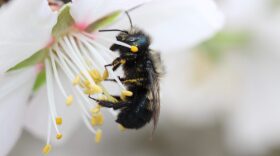-
(Runtime 4:10)On a warm day in Centralia, Washington, south of Olympia, Alan Woods is standing surrounded by his 90 million bees.“So, we’re in the middle…
-
The state Agriculture Department had spent weeks searching, trapping and using dental floss to tie tracking devices to Asian giant hornets, which can deliver painful stings to people and spit venom but are the biggest threat to honeybees that farmers depend on to pollinate crops.
-
Researchers in Washington have lost track of an Asian giant hornet they were following — a stinging setback in the pursuit to eradicate an invasive species that threatens to decimate North American bee populations.
-
Bee colony death continues to rise. According to the Bee Informed Partnership's latest survey, released this week, U.S. beekeepers lost nearly 40% of their honey bee colonies last winter — the greatest reported winter hive loss since the partnership started its surveys 13 years ago.
-
This beekeeper lost more than half of his hives over the winter — 50,000. And he's not alone.
-
Hundreds of citizen scientists have begun buzzing through locations across the Pacific Northwest seeking a better understanding about nearly 30 bumblebee species.
-
Honey bees are struggling with habitat loss, colony collapse disorder, and other challenges. One Northwest beekeeper is rethinking the kinds of bees we use to pollinate crops in the first place.
-
American honey bees don’t do well in winter. It's a serious problem for beekeepers. They experience their biggest losses during winter – and beekeepers…
-
Forty-two percent of America’s honey bees died in 2014. On average, beekeepers lose about 30 percent of their colonies annually – a number seen since…
Play Live Radio
Next Up:
0:00
0:00
Available On Air Stations








